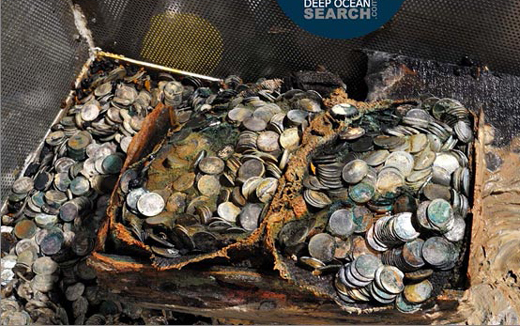Tons of 1 rupee British raj coins found in 1942 shipwreck
mangaloretoday.com
London, April 17: Over 70 years after a British steampship from Bombay carrying tons of Indian 1 rupee silver coins to help fund Britain in World War II was torpedoed by a German submarine, its wreck has been discovered in a record deep-dive operation.
The SS City of Cairo (Captain William Rogerson) was a mixed cargo and passenger ship belonging to Ellerman Lines and was on a voyage from Bombay to England, via Cape Town and Recife, Brazil, unescorted, in late 1942, in the middle of World War II.

The wreck British steampship carrying tons of Indian 1 rupee silver coins to help fund Britain in World War II has been discovered in a record deep-dive operation. (Photo Courtesy: Deep Ocean Search)
The ship carried 296 people of which 136 were passengers and a mixed cargo including some 100 tons of silver coins belonging to the UK Treasury. It was spotted by U-68 on the 6th of November 1942 and torpedoed near St Helena in the south Atlantic at 2030 hrs.
The story of the torpedo is known and has been the subject of at least one book, but the shipwreck was never found until Deep Ocean Search (DOS), a company specialising in such operations, took on the challenge under a contract with the UK government.
The company gets to keep an unspecified amount of the coins under the contract with the Ministry of Transport. DOS said it recovered several tens of tons of silver coins from a depth of 5150m – a world depth record. The haul is expected to be worth millions of pounds.
The story goes that the surviving crew and passengers were in lifeboats when the submarine approached to question captain Rogerson. The U-Boat captain, Karl-Freidrich Merten, told him how far he was from Brazil and left saying, “goodnight, sorry for s
DOS said: “This was to be a difficult search as the water depth would exceed 5000m, the weather, swell and currents were known to be challenging and the presumed site was some 1000 miles from the nearest land in the foothills of the mid-Atlantic ridge”.
It added: “Our research came up with the usual contradictions between the positions given by the submarine and that from the ships officers. A large search box was put together to try to reconcile these diverse statements. The seafloor was difficult with ridges and canyons throughout the area and the water depth varied between 5100 and 5500m”.
Divers founds that the ship was broken in two and buried deep in the seafloor silt. Parts of the ship had meters of mud heaped upon it.
“The combination of pressure, temperature, repeated dives at this depth and other issues resulted in multiple breakdowns of systems such as we had not experienced before when working in 3000 - 4000m depths…However our team overcame them”.
The DOS team left a plaque commemorating the finding and visiting the ship before they left the site finally.
- GAIL Gas Limited signs PNG Agreement with The National Institute of Technology Karnataka
- After deciding to contest as independent in MLC polls, Raghupathi holds supporters meet
- Summer special trains between Mangaluru Central-Coimbatore Junction
- Kasargod: Student dies; 3 injured as 2 bikes collide
- NMAM Institute of Technology team shines in Boeing National Aeromodelling competition
- News about ‘closure’ of Palakkad Railway Division is baseless
- Boating facility at Malpe suspended till September 15
- Udupi: Closed hotel gutted in fire mishap
- Yellow alert declared across coast till May 20
- DC directs all departments to gear up for monsoon eventualities
- Bantwal: Overtaking bid claims life of bike rider
- Mangalore Universiy invites applications for affiliation
- Belthangady: Man develops cost-efficient rainwater harvesting filter
- 14 People given Citizenship Certificates for the first time under CAA
- United Nations apologises to India for death of ex-Army officer in Gaza
- Neighbour stabs Karnataka woman, 20, to death after she rejects advances
- Facebook users face outage globally, Instagram also down for thousands of users
- SIT arrested Revanna to tarnish Deve Gowda’s image: H D Kumaraswamy
- 14 rescued from collapsed lift at Rajasthan mine in overnight op
- S Jaishankar responds to US sanction warning over Chabahar Port deal
- 6 Dead as bus catches fire after collision with another vehicle in Andhra
- I never said Hindu or Muslim, I talked about...: PM Modi
- Salman Khan house firing incident: Case filed against gangster Rohit Godara
- Solar storm that recently hit earth was most intense since 2003: ISRO
- PM Modi doesn’t own house, car, has Rs 52,000 in cash: Election affidavit
- New residential complex for the judges inaugurated in Mangaluru
- Absconding accused nabbed after 8 years
- Truck with cylinders turns turtle in Beltangady
- Bhoota Kola artist dies of cardiac arrest
- Development of the country should be our goal: Ganesh Karnik
- Container truck gets stuck under Modankap railway bridge
- Truck crushes bike’s pillion rider near BC Road
- Head constable dies of heart attack
- Udupi: PDO dismissed over financial irregularities
- CREDAI to resume Skill Development Program for Construction Workers in Mangaluru
- John B Monteiro elected president of Rachana Catholic Chamber of Commerce & Industry
- Sudhanshu Rai elected district president of All College Student Association
- Chief Minister to visit Mangaluru, Udupi on August 1
- Nitte University awards PhD degree to Tina Sheetal D’Souza
- Sachitha Nandagopal honoured by CMTAI for Community Service
- CITY INFORMATION
- TRAVEL
- TOURIST INFORMATION
- HEALTH CARE
- MISCELLANEOUS




 Write Comment
Write Comment E-Mail To a Friend
E-Mail To a Friend Facebook
Facebook Twitter
Twitter  Print
Print 

